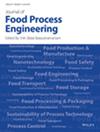The process of deep-frying brings about significant physicochemical changes in the color and moisture content of foods, influenced by heat and mass transfer phenomena. Achieving consistent quality in fried foods, such as nuggets, fries, and chicken pies, is challenging, highlighting the importance of predicting these changes. This study delves into the evolving dynamics of color and moisture content, specifically in French fries during deep frying. To model these changes, the study employs a first-order kinetic equation for color and moisture content, utilizing numerical solutions like the Runge–Kutta fourth-order method as well as the Nelder–Mead algorithm in MATLAB. The Arrhenius equation plays a key role in this model. The modified model is compared against an existing model using the root mean square error (RMSE) and Akaike information criterion (AIC). Note that the investigation evaluates how oil temperature (at 150, 170, and 190°C) as well as sample thickness (at 5, 10, and 15 mm) impact the French fries' moisture and color content during frying. Results indicate that the modified model, with its improved accuracy and lower RMSE and AIC values compared to the existing model, provides a more reliable tool for understanding the frying process. Consequently, the inclusion of a user-friendly graphical interface (GUI) makes this modeling approach accessible even to those with limited mathematical or programming expertise, benefiting professionals seeking more profound insights into the frying process.
The graphical user interface (GUI) for predicting deep-fried food quality presented in this study holds broad industrial applications. It serves as a pivotal tool in the food industry for ensuring consistent quality across products like fries and nuggets, enabling manufacturers to optimize frying processes. Fast-food chains can use the GUI to minimize costs and energy consumption while maintaining product quality. In addition, it aids in equipment calibration, becoming an invaluable asset for operators seeking optimal performance and longevity in deep-frying equipment. Culinary schools benefit from this GUI as an educational tool, offering aspiring chefs a practical understanding of deep-frying science. Researchers and food scientists can accelerate R&D cycles by efficiently assessing the impact of variables. SMEs, regulatory bodies, and food retailers find utility in the GUI for quality control, compliance, and consumer education, collectively contributing to industry transparency, sustainability, and improved global health outcomes.


